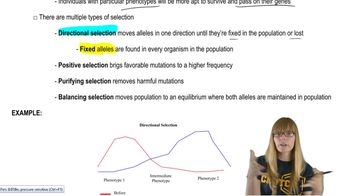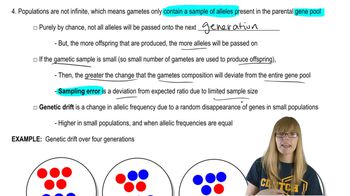Table of contents
- 1. Introduction to Genetics51m
- 2. Mendel's Laws of Inheritance3h 37m
- 3. Extensions to Mendelian Inheritance2h 41m
- 4. Genetic Mapping and Linkage2h 28m
- 5. Genetics of Bacteria and Viruses1h 21m
- 6. Chromosomal Variation1h 48m
- 7. DNA and Chromosome Structure56m
- 8. DNA Replication1h 10m
- 9. Mitosis and Meiosis1h 34m
- 10. Transcription1h 0m
- 11. Translation58m
- 12. Gene Regulation in Prokaryotes1h 19m
- 13. Gene Regulation in Eukaryotes44m
- 14. Genetic Control of Development44m
- 15. Genomes and Genomics1h 50m
- 16. Transposable Elements47m
- 17. Mutation, Repair, and Recombination1h 6m
- 18. Molecular Genetic Tools19m
- 19. Cancer Genetics29m
- 20. Quantitative Genetics1h 26m
- 21. Population Genetics50m
- 22. Evolutionary Genetics29m
21. Population Genetics
Allelic Frequency Changes
Problem 2b
Textbook Question
Write a short essay describing the roles of mutation, migration, and selection in bringing about speciation.
 Verified step by step guidance
Verified step by step guidance1
Start by defining speciation, which is the process by which populations evolve to become distinct species.
Explain the role of mutation in speciation: Mutations introduce genetic variation by altering DNA sequences, which can lead to new traits that may be advantageous, neutral, or deleterious.
Discuss migration (gene flow) and its impact: Migration involves the movement of individuals between populations, which can introduce new genetic material and increase genetic diversity, potentially leading to speciation if populations become isolated.
Describe natural selection and its influence: Natural selection acts on genetic variation, favoring traits that enhance survival and reproduction, which can lead to the accumulation of differences between populations over time.
Conclude by explaining how the interplay of mutation, migration, and selection can lead to reproductive isolation, a key factor in the formation of new species.
Recommended similar problem, with video answer:
 Verified Solution
Verified SolutionThis video solution was recommended by our tutors as helpful for the problem above
Video duration:
4mPlay a video:
Was this helpful?
Key Concepts
Here are the essential concepts you must grasp in order to answer the question correctly.
Mutation
Mutation refers to changes in the DNA sequence of an organism's genome. These alterations can occur spontaneously or be induced by environmental factors. Mutations introduce genetic variation, which is essential for evolution, as they can lead to new traits that may be advantageous, neutral, or deleterious. Over time, beneficial mutations can accumulate, contributing to the divergence of populations and the formation of new species.
Recommended video:
Guided course

Mutations and Phenotypes
Migration
Migration, or gene flow, is the movement of individuals and their genetic material between populations. This process can introduce new alleles into a population, increasing genetic diversity. When populations migrate and interbreed, they can share beneficial traits, but if populations become isolated, migration can also lead to distinct evolutionary paths. This isolation is a key factor in speciation, as it can result in the development of unique adaptations in different environments.
Recommended video:
Guided course

New Alleles and Migration
Selection
Natural selection is the process by which certain traits become more common in a population due to their advantageous effects on survival and reproduction. Organisms with favorable traits are more likely to survive and reproduce, passing those traits to the next generation. Over time, selection can lead to significant changes in a population's genetic makeup, driving speciation as populations adapt to different ecological niches or environmental pressures, ultimately leading to the emergence of new species.
Recommended video:
Guided course

Natural Selection

 5:58m
5:58mWatch next
Master Natural Selection with a bite sized video explanation from Kylia Goodner
Start learning


